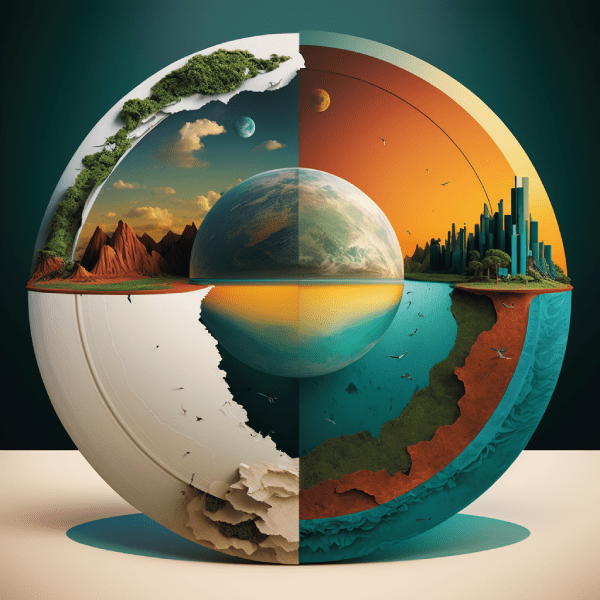Planetary boundaries are a set of biophysical thresholds that define the safe operating space for human activities on the Earth’s system. These boundaries were first proposed in 2009 by a group of scientists led by Johan Rockström, and they represent the limits beyond which human activities could cause irreversible and catastrophic changes to the planet’s systems. In this blog post, we’ll dive deeper into what planetary boundaries are, why they matter, and what can be done to prevent the consequences of crossing them.
What are planetary boundaries?
Planetary boundaries are a framework that identifies nine biophysical processes that are essential to the Earth’s systems and sets a safe threshold for each of them. These nine processes are climate change, biodiversity loss, land use change, freshwater depletion, ocean acidification, ozone depletion, atmospheric aerosol pollution, chemical pollution, and nitrogen and phosphorus cycles. Each boundary represents a critical aspect of the Earth’s systems, and human activities can disrupt these processes, leading to irreversible and catastrophic changes to the planet’s ecosystems.
Why do planetary boundaries matter?
The concept of planetary boundaries matters because human activities are pushing the Earth’s systems beyond their safe limits. For example, the concentration of carbon dioxide in the atmosphere has surpassed the safe limit of 350 ppm, leading to global warming and climate change. Similarly, the loss of biodiversity has accelerated at a rate far beyond the safe threshold, with an estimated one million species facing extinction in the near future. Crossing these boundaries puts the planet’s ecosystems and human well-being at risk, and urgent action is needed to prevent further harm.
What can be done to prevent the consequences of crossing planetary boundaries?
Preventing the consequences of crossing planetary boundaries requires a collective effort by individuals, governments, and organizations. To prevent or mitigate the consequences of crossing these boundaries, we can take several actions, including:
- Reducing greenhouse gas emissions by shifting towards renewable energy sources and improving energy efficiency.
- Protecting biodiversity by protecting and restoring ecosystems, reducing deforestation, and reducing pollution.
- Managing resources sustainably by reducing waste and implementing sustainable practices in agriculture and industry.
- Reducing consumption levels by promoting circular economy models, reducing food waste, and encouraging the use of public transportation.
- Collaboration by setting and adhering to international environmental agreements, such as the Paris Agreement, and promoting public awareness and education about sustainable practices.
Conclusion
The concept of planetary boundaries highlights the urgent need for collective action to ensure the long-term sustainability of the planet’s systems. By understanding these boundaries and taking action to prevent or mitigate the consequences of crossing them, we can work towards a more sustainable future for ourselves and for future generations. It’s time to take action and work together to protect the Earth’s systems and ensure a safe operating space for human activities.
Interesting facts
- The concentration of carbon dioxide in the atmosphere has surpassed the safe limit of 350 ppm, currently standing at around 415 ppm. (Climate change)
- An estimated one million species are facing extinction in the near future due to human activities like deforestation, overfishing, and pollution. (Biodiversity loss)
- Human activities have disrupted the natural flow of nitrogen and phosphorus, leading to pollution of waterways, eutrophication, and harmful algal blooms. (Nitrogen and phosphorus cycles)
- The conversion of natural habitats, such as forests and wetlands, for agriculture, urbanization, and other purposes has led to a loss of biodiversity, soil degradation, and increased carbon emissions. (Land use change)
- The overuse and pollution of freshwater resources, such as rivers and aquifers, has led to a depletion of these resources and threatens the availability of clean water for human and ecological needs. (Freshwater depletion)
- The increase in atmospheric carbon dioxide has led to the acidification of oceans, which threatens the survival of marine organisms and ecosystems. (Ocean acidification)
- The use of ozone-depleting substances, such as chlorofluorocarbons (CFCs), has led to a thinning of the ozone layer in the atmosphere, which increases the risk of skin cancer and other health effects. (Ozone depletion)
- The release of fine particulate matter (PM2.5) and other air pollutants from human activities, such as burning fossil fuels, has led to respiratory and cardiovascular health problems and negative impacts on ecosystems. (Atmospheric aerosol pollution)
- The release of synthetic chemicals, such as pesticides and industrial chemicals, into the environment has negative impacts on human health and ecosystems. (Chemical pollution)



